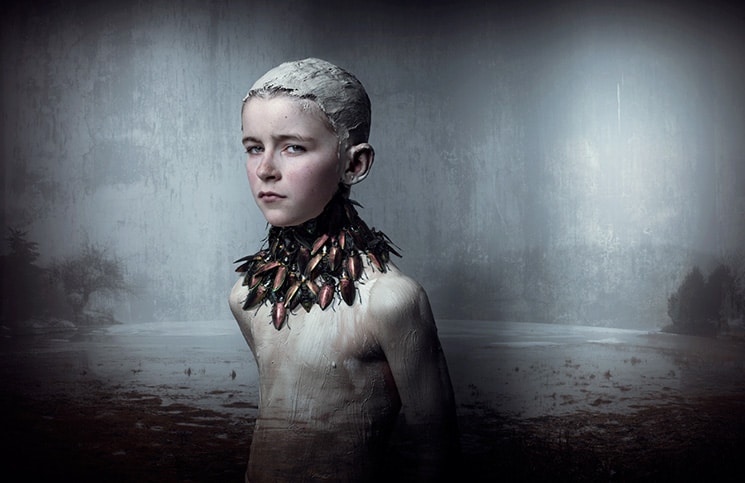Bear Kirkpatrick defines his imagery as evidence. He looks for proof of the invisible, rejected memories and forgotten histories, nameless inherited traits, even signs of a sacred world hidden behind this one.
His portraits often reveal by concealing. He might use veiling layers of fabric to direct attention to the eyes, or cover a model in mud that’s suggestive of indigenous tribes.
But in an exhibition at Drift Gallery in Portsmouth, Kirkpatrick’s renowned portraits are expounded upon with related ephemera in their own frames, a new series called “Human Diorama.” The installations include hand-written notes, thick locks of red hair, moss, snakeskin, horseshoe crab tails, and more signs of varied and extraordinary life. Clustered together, these objects and photographs are wonder walls of natural history and creative beauty.
Adding to this are mixed media sculptures by Amy Gross, whose surreal organisms morph her inner life and the natural world, and the archetypal figure sculpture of Christopher Gowell.
The exhibition, “Human Nature,” is an exploration. It’s as though the artists are sharing astonishing discoveries from uncharted lands, real and imagined, or somewhere in between.

Above and top of page: Bear Kirkpatrick’s photos are part of the exhibit Human Nature, on view at Drift Contemporary Art Gallery in Portsmouth.
Some of the photos are from Kirkpatrick’s “Old Ones” series, in which he investigates the possibility of memories passed down for generations. In addition to mud, there are other adornments, like a collar of dead beetles or coat of milkweed seed. There are also post-production patterns that double as wallpaper and tattoos, or backgrounds of raw landscapes. It’s all at once strangely familiar and surprisingly new.
The series, “Hierophanies,” looks for evidence of a sacred world beyond the profane world of living things. Kirkpatrick says it exists as a memory of a place before death. He evokes this with dramatic views of bodies entangled in the dark wilderness.
“Early Settlers” is based on historical record and the artist’s own ancestors, including Anne Hutchinson, who was banished from the Massachusetts Bay Colony, but is now considered a champion for religious freedom and civil liberties. She is cloaked in darkness, but a bold spirit shines through. Another image portrays one of Hutchinson’s followers, who delivered a stillborn child, described as having horns. She is shown looking lovingly at the limp fawn in her arms. These portraits and their stories are especially haunting.
Unlike Kirkpatrick’s ephemera, and despite appearances, the sculptures that Gross creates are completely unnatural, made from textiles and beads to look organic. And since they are meant to merge inner life with the outdoors, there are things like fabric fungi and turning leaves with unexpected eyeballs, and vibrant heart-shaped organs with hidden beehives.
“They mimic the visible and the invisible, the observed and imagined,” she says. “Their symbiosis suggests not only what can be seen, but also what cannot: the early alterations of time, the first suggestions of disintegration.” Her organisms are a way of stopping time and stilling transformation, a human conceit based on the knowledge of our mortality.
Gowell’s sculptures put focus back on the exterior and whole shape of the body with all of its intrinsic beauty and potential for symbolism. She draws on traditions, technical skill, and anatomical knowledge, but also imbues her work with the passion and magic of her invention. Navigating around these solid presences is a reminder of our own bodies and the mystery of being.
“Human Nature” ends with Drift Gallery’s season on Oct. 24, making right now the best time and last chance to visit this year.
Drift Gallery is located at 375 Little Harbor Road, in Portsmouth, at the Wentworth-Coolidge Mansion historical site.
